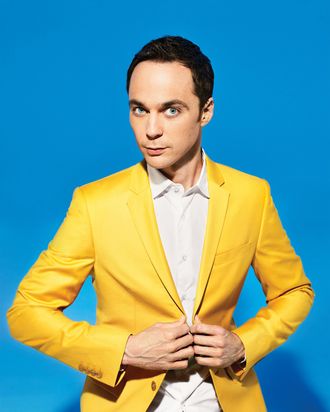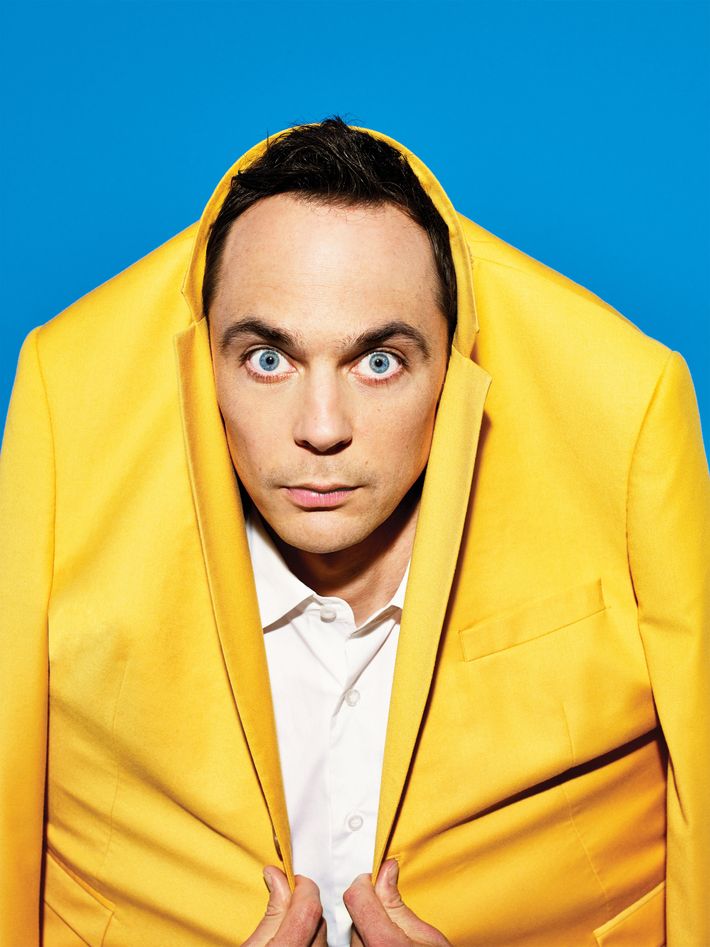
The first thing Jim Parsons bought after he got famous was a house—a nice one in Los Feliz—but that didn’t feel like an extravagance, really: Everybody needs a place to live. His next major expenditure, though—the indulgence, the toy he didn’t need but wanted anyway, because he’s won three Emmys and because his CBS sitcom, The Big Bang Theory, is watched by 23.4 million people every week, and because when you’re that successful, why not?—was a white Mercedes SL550 roadster. It has red-leather bucket seats, wood paneling, and a satellite radio (tuned to a station called Chill). It is beautiful. And today, it might be trying to kill him.
Specifically, the car’s GPS system is asking Parsons, 41, to turn into oncoming Los Angeles traffic, or maybe north on the 405, where he is definitely not headed. (He is trying to drive us to lunch at Ammo, a restaurant in Hollywood.) “What does she want?!” he keeps asking. The female voice coming from the dashboard tells him to drive into a wall. “What happened? Where did we go so wrong? Who’s honking, and why?” Actually, everyone is honking, and they continue to do so as Parsons cuts across three lanes—“Look, she’s looking at me going, Why aren’t you doing anything I’ve asked you to do?”—and makes a left back toward the East Side. We hit more traffic. “I mean, honestly, look at us.”
So playing a nerd on The Big Bang Theory has not made Parsons a computer expert. He’ll tell you this himself in his Texan (by way of theater school) drawl. After seven seasons playing Sheldon Cooper, a socially challenged theoretical physicist—his first major role after bit parts in everything from Ed to Garden State—Parsons still uses Dictionary.com to figure out how some of the big words in his scripts are pronounced. His cultural references include Agatha Christie (“Ugh, Miss Marple, I love her”) but not Star Trek. He is as mystified by science as he is by the outsize success of his very science-y show, which gets ratings on par with the ones Friends did in the pre-DVR era. “It’s crazy,” he says. “You’ll hear no other better word from me on the topic.”
When pressed, Parsons will offer two possible explanations for Big Bang Theory’s success. First, he posits that the show is more accessible than others because the characters—primarily four geeks from Caltech and their ditzy blonde neighbor—have stayed largely the same for all seven seasons. “There’s not anything to keep up with. You don’t go, I didn’t see the first three seasons, and now they’re off with prostitutes, and they no longer work in the Mafia, and I don’t understand what happened. People have so many choices on TV now, so no one’s asking for you to marry us. You can enjoy our show without a weekly appointment.” (“I don’t say that critically of other shows,” he adds immediately. Parsons does this a lot—clarifying anything, even a Diet Coke order, to make sure he hasn’t offended anyone. It is the easiest way to tell him apart from the possibly on-the-spectrum Sheldon, who “has a brutal level of honesty about him,” says Parsons. “Unknowingly a lot of the time.”)

His second hypothesis is weirder: “I think it’s as simple as the look of the show.” (It’s a multi-camera sitcom, with lots of primary colors, set in two apartments that are never really redecorated.) “It’s a bit of eye candy in its own way.” He came up with this theory in Rome, while promoting the show’s first season, when “nobody in Italy knew who the hell we were.” The fans who stopped him were all Brazilian tourists. “What confused me was—does our show subtitle well?” he says. “Especially some of the shit a couple of us say, as far as the science jargon goes. So I thought, Maybe it’s just literally fun to look at.”
We pass the restaurant. (“Oh, there it was. I’ll turn around.”) As soon as we’re seated, a man at the next table begins chatting up Parsons, which happens a lot, he says, but not in a way that treads on his privacy. The paparazzi don’t follow him, even after his public coming out (in 2012, after a decade with his partner, art director Todd Spiewak), which he calls a heartening experience. “All the reactions I got were positive. And the other positive was that there was almost no reaction at all, which was, for me, the most close-up view of progress I’d ever personally seen. This is less and less interesting by the day.”
On his own time, Parsons avoids television—it feels a little like work—unless sports are involved. Then he’ll watch it all: football (he’s also in a fantasy league); basketball (he grew up in Houston and follows the Rockets); golf (“Oh, God, if I’m available, I watch every round of a Masters”). About a year ago, he became pen pals with Genie Bouchard, a professional tennis player, when he found out that she’s a fan of his show; he emails her after every match. At some point during lunch, Parsons mentions that he’s going to the Met Ball and speculates on whether Roger Federer, friend of Anna Wintour, will be there. “All I have to say to him is that I’m such a fan. And the only thing I ever hope is that there’s a slim chance that, for some reason, he and his wife fall asleep watching Big Bang Theory reruns. What heaven would that be.”
We settle the bill and head out to the parking lot to look for his car. He says he’s recently started thinking about life after Sheldon, but he just signed on for three more seasons of Big Bang Theory, so that’s a ways off. Plus, he’s still having fun: “Why bother thinking of things that would make me hate this and then leave?” he says. For now, he prefers to enjoy everything the show has given him: satisfying work, a part in Ryan Murphy’s upcoming HBO movie The Normal Heart (in which he’ll star as hospital administrator Tommy Boatwright, the same role he played in Heart’s 2011 Broadway revival), another new house in Los Feliz (he recently listed the old one and bought a bigger home from previous owner Robert Pattinson), and his Mercedes, which we finally locate behind a valet gate. He waits for my Uber confirmation, gives me a warm good-bye, and hops in. Then he drives away in the wrong direction.
*This article appeared in the May 5, 2014 issue of New York Magazine.

